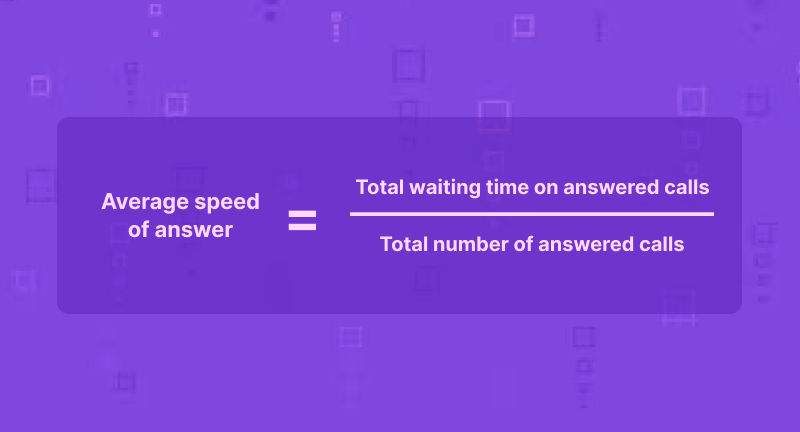
For call center managers and supervisors, understanding and optimizing key metrics is crucial for delivering exceptional customer service. Among these metrics, the Average Speed of Answer (ASA) stands out as a critical indicator of both agent performance and customer satisfaction.
This exclusive manual will explore all the nuances of ASA, including its definition, calculation, improvement strategies, and industry benchmarks.
Get a Glimpse into the Convin Call Center Software to Lower ASA
Understanding the Average Speed of Answer: A Fundamental Call Center Metric
1. What is the Average Speed of Answer (ASA)?
- Definition: ASA is the average time taken for a call center agent to answer an incoming call. This metric is pivotal in assessing the efficiency and responsiveness of a call center.
- Impact on Customer Experience: A lower ASA typically indicates a more efficient call center, leading to higher customer satisfaction as callers are not kept waiting.
2. Average Speed of Answer Formula: The Calculation Essentials
- Basic Formula: The average speed of answer is calculated by dividing the total wait time for answered calls by the total number of answered calls.
To understand ASA In its simplest form, it is calculated as
ASA = Total Wait Time for Answered Calls/Total Number of Answered Calls
For Example: If the total wait time for a day is 2000 seconds and the total number of answered calls is 100, then ASA = 2000 / 100 = 20 seconds.
Many modern call center systems include built-in tools for automatically calculating ASA, providing real-time and accurate data for analysis.

Strategies to Improve Average Speed of Answer
1. Optimizing Agent Performance
- Training and Development: Regular training sessions can enhance agent efficiency, directly impacting ASA.
- Skill-Based Routing: Implementing skill-based routing ensures calls are directed to the most appropriate agent, reducing wait times.
2. Enhancing Call Center Processes
- Streamlining Call Flows: Simplifying call flows can reduce the time taken to connect a caller to the right agent.
- Workforce Management: Effective scheduling ensures that enough agents are available during peak times, which is crucial for maintaining a low ASA.
Results first, payment later.
The Importance and Best Practices of Average Speed of Answer (ASA) in Call Centers
The Average Speed of Answer (ASA) is a critical metric in the call center industry, serving as a key indicator of both customer satisfaction and operational efficiency. Its importance lies in several areas:
- Customer Satisfaction: ASA is directly linked to the customer experience. Longer wait times can lead to frustration and dissatisfaction, potentially impacting customer loyalty and retention. A lower ASA means that customers are connected to an agent more quickly, enhancing their overall experience.

- Operational Efficiency: ASA provides insights into the efficiency of call center operations. It helps in identifying staffing issues, peak call times, and the effectiveness of call routing strategies.
- Agent Performance: Monitoring ASA can also indicate how well agents are managing their workload. A high ASA might suggest that agents are overwhelmed or underperforming, necessitating additional training or changes in workflow.
- Business Growth and Reputation: A company's reputation is heavily impacted by the caliber of its customer service in today's competitive marketplace. A low ASA suggests that a company is handling calls efficiently, which can improve its reputation and lead to more business and satisfied customers.
Best Practices for Managing Average Speed of Answer
To effectively manage ASA and improve call center performance, consider the following best practices:
- Optimize Staffing Levels: Historical data can be used to forecast busy periods and schedule staff accordingly, while flexible scheduling allows for quick adaptation to unexpected call volume fluctuations.
- Enhance Agent Training and Support: Regular training and the provision of supportive tools are essential for agents to enhance their efficiency in handling calls.

- Implement Efficient Call Routing: Skill-based routing directs calls to appropriate agents based on their skill set, ensuring quicker resolution, while IVR optimization reduces wait times using Interactive Voice Response systems.
- Leverage Technology: Utilize workforce management software for precise forecasting and scheduling, and utilize real-time analytics to monitor ASA and other metrics for immediate adjustments.
- Focus on First Call Resolution (FCR): Empower agents by providing them with the necessary information and authority to resolve issues on the first call, thereby reducing the frequency of repeat calls.
- Monitor and Analyze Performance: Regular reviews and feedback loops are essential for analyzing ASA and related metrics, identifying areas for improvement, and ensuring a comprehensive understanding of the system.
- Balance ASA with Other Metrics: The holistic approach involves incorporating metrics like Average Handle Time (AHT) and Customer Satisfaction (CSAT) alongside ASA to ensure overall service quality.
- Continuous Improvement: The ASA management process is an ongoing process that aims to refine and improve call center operations.
- Balancing Metrics: The service level, which measures the percentage of calls answered within a specific threshold, should be balanced with the speed of answering calls.
- Setting the Benchmark: The ASA (Audit Service Acceptance) can vary across industries, and setting realistic benchmarks based on industry standards, call center size, and customer expectations is crucial.
- Setting Realistic Goals: Historical data analysis helps set achievable ASA goals, while continuous monitoring allows for adjustments to strategies based on benchmarks.
Comprehensive Metrics: Beyond ASA
1. Average Handle Time (AHT) and First Call Resolution (FCR)
- Average Handle Time: This metric measures the average duration of a call, including talk time and related tasks. AHT provides insights into the efficiency of call handling.

- First Call Resolution: FCR tracks the percentage of calls resolved on the first contact. A high FCR often correlates with a lower ASA, as efficient resolutions reduce the volume of repeat calls.

2. The Role of Average Talk Time
- Understanding Average Talk Time: This metric measures the average duration of a conversation with a customer. While a lower average talk time can contribute to a lower ASA, it's crucial to balance this with the quality of service.
Average Speed of Answer (ASA) and Its Impact on the Customer Experience
The Average Speed of Answer (ASA) is a critical metric in call center operations, directly influencing the customer experience. Understanding its impact requires a deep dive into what ASA is and how it shapes the perceptions and satisfaction of customers interacting with a call center.
The Direct Impact of ASA on Customer Experience
- First Impressions: Lower ASA meets customer expectations for quick responses, creating a positive first impression. Quick answer times are often seen as efficient and professional, enhancing a company's image.
- Customer Satisfaction and Loyalty: Minimizing wait times in call centers can reduce customer frustration and increase repeat business, fostering loyalty and reducing the need for long wait times.
- Impact on Customer Emotions: Extended waiting times can cause customer stress and annoyance, while quick responses can create a positive emotional state, enhancing the overall interaction.
ASA and Its Role in Overall Service Quality
- Part of a Bigger Picture: While ASA is crucial, it's important to remember that it's just one aspect of the overall customer experience. The quality of the interaction post-answer is equally important.
- Balancing Speed and Quality: There needs to be a balance between quickly answering calls and providing high-quality, effective service once the call is answered.

Optimize and attain higher customer satisfaction levels
Implementing Effective ASA
Effectively controlling the average response time is essential for any call center that wants to deliver top-notch customer support. By implementing these best practices, call centers can not only improve their ASA but also enhance overall customer satisfaction, agent performance, and operational efficiency.
1. How to Calculate ASA: A Step-by-Step Approach
- Data Collection: Regularly collect data on total wait times and the number of answered calls.
- Accurate Calculation: Use the ASA formula or automated tools to calculate the metric accurately.
2. Continuous Improvement: How do you improve the average speed of answer?
- Regular Reviews: Conduct frequent reviews of ASA and related metrics.
- Feedback and Training: Use agent feedback and performance data to inform ongoing training and development programs.
The Path to Call Center Excellence
Mastering the average speed of answer is a strategic journey for call center managers.
Understanding the definition, formula, and calculator helps gain insights. Balancing ASA with other metrics like handle time, talk time, and first-call resolution is crucial for achieving excellence. Remember, the goal is not just to reduce wait times but to enhance the overall customer experience and agent performance.
Try a free demo of one of the best contact center software programs available in the market today.
FAQs
1. How do you calculate the average speed of an answer in a call center?
The Average Speed of Answer (ASA) in a call center is calculated by dividing the total wait time for answered calls by the total number of answered calls.
The formula is: ASA = Total Wait Time for Answered Calls / Total Number of Answered Calls.
2. How is the call center answer rate calculated?
In order to determine the answer rate in a call center, divide the total number of calls answered by the number of incoming calls. Then, multiply the result by 100 to obtain the percentage. Answer Rate (%) = (Number of Calls Answered / Total Number of Incoming Calls) × 100.
3. How do you answer average speed?
To answer or report the average speed (likely referring to ASA in this context), you would calculate the ASA using the above formula and then present the average time in seconds or minutes. For example, "The average speed of answer in our call center is 30 seconds."
4. What is the formula for call center metrics?
There isn't a single formula for all call center metrics, as each metric has its own calculation. Common metrics include:
- Average Handle Time (AHT): AHT = (Total Talk Time + Total Hold Time + Total After-Call Work) / Total Number of Calls Handled
- First Call Resolution (FCR): FCR (%) = (Number of Issues Resolved on First Call / Total Number of Issues) × 100.
- Occupancy Rate: Occupancy Rate (%) = (Total Handle Time / (Total Handle Time + Total Available Time)) × 100.
- Service Level: Typically, a percentage of calls are answered within a certain time threshold, e.g., 80% of calls are answered in 20 seconds.

































.webp)









